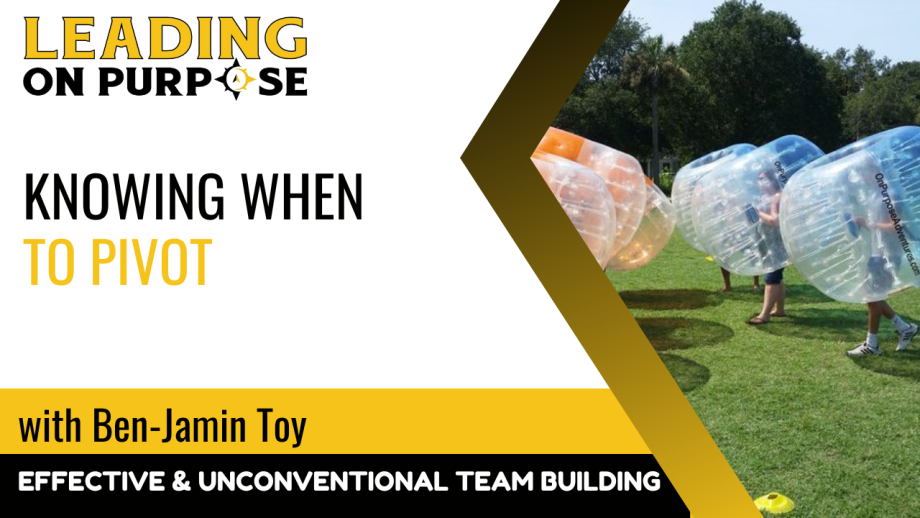
Knowing When to Pivot
How do you know when it's time to throw in the towel?
When should you pivot or start over?
The motivational quote on the break room wall says to never give up.
But the CEO dissolved five businesses before she discovered her million-dollar idea.
The journey is rarely a straight line from idea to success. It's often a winding road filled with twists, turns, and unexpected obstacles.
One of the toughest challenges entrepreneurs face is knowing when to pivot, evolve, or even throw in the towel entirely.
Recognizing the Signs
When an entrepreneur starts a new business, they can expect to be in the red for a certain amount of time. This differs from industry to industry. On average, businesses take two to three years to become profitable. Once a startup reaches year four, if profits aren't appearing, it's time to pivot or stop and start over.
In those first few years, start ups should see higher incomes in the second year over the first and the third year over the second. Those profits can be reinvested into the business to jumpstart growth, but finances should be analyzed to ensure the numbers are showing that the idea behind the business is marketable.
What about customers? Organizations should be hearing from clients that the service or product is needed and important. If customers are providing constructive criticism, entrepreneurs should quickly pivot to improve their business model to fit the needs of the client.
Decisions don't need to be made based on a feeling. They can be made based on data, finances, and customer feedback. These reliable metrics provide step-by-step guides for whether entrepreneurs should pivot, evolve, reinvent, and/or stop and start over. Following your gut can be a business death sentence when it directly goes against what the data is showing.
There's no one-size-fits-all answer, but there are signs that can help guide your decision-making process.
When thinking of businesses that quickly change course, the industry that sticks out is restaurants, specifically Charleston hotspots. With rents the way they are, lowcountry restaurants have to fill tables to stay alive. And when something isn't working, they have to quickly change menu items, hire competent staff, and perfect the vibe in order to stay afloat. Steve Palmer, founder of the Indigo Road Hospitality Group, said "I think, like a lot of people, we tried a lot of different pivots."
Learning from Experience
Take it from someone who's been there. In 2015, we bought 24 (eventually 40) inflatable bubble balls and created Lowcountry Bubble Soccer. At the beginning of my entrepreneurship journey after leaving the corporate world, I didn't buy franchises but invented services myself. I came up with my own pricing, and with Lowcountry Bubble Soccer, I got the pricing wrong. I overstaffed because I didn't have clear definitions of how much staff was needed for different-sized events. Due to the overstaffing and bubble repairs, the business became hard to manage.

Hindsight is 20/20. I recognize today that I kept this business around for about a year longer than I should have just to keep employees busy. But my people were as frustrated with this service as I was given the events took place during the heat of summer.
My desire for success primarily for my employees made me hang on to a unprofitable business for longer than I should have. I should have sold the business earlier.
What can be learned from my mistake?
I didn't have a good metric to evaluate what was a losing proposition. When we started Charleston Combat Archery, I started with proper pricing which has even been increased several times since then. I learned from the mistake of improperly pricing bubble soccer events too low for it to ever become profitable. This lesson has made Charleston Combat Archery a successful offering for group gatherings.
Next, the staffing issue that occurred with Lowcountry Bubble Soccer, I corrected from the start with Combat Archery. I clearly defined the number of staff that would be needed based on a head count of participants. I cannot pay more employees than are needed to lead an event. This can make an entire program not profitable which doesn't help the employees or the business.
Nobody wants to lose money, but costly errors can make great teachers if you are willing to learn and grow.
Lastly, it is important to move on from losing ideas, but we can still find the positives and learn the lessons. Lowcountry Bubble Soccer opened a lot of doors for On Purpose Adventures and created lead generation from companies who would hire us for bubble soccer entertainment then they would sign their teams up for a the Holy City Wanderer scavenger hunt, then do a team building retreat.
Embracing Change
But perhaps the most valuable lesson of all was learning to embrace change. As entrepreneurs, we're often told to be persistent and never give up on our dreams. And while persistence is important, so too is knowing when to admit defeat and move on to something new.
I have a tendency to dig in my heels and say everything will be alright. It's not always easy to pull the plug on a failing venture, but sometimes it's the best decision for everyone involved—the customers, the employees, and the business itself.
An example of an organization who embraced change is Kimberly-Clark. They were the leader in the business paper industry when they decided to sell the last of their paper mills and go into the consumer products market. Last year they netted sales of $5 billion so I think the pivot worked out for them.
Moving Forward
In the end, every failure is an opportunity to learn and grow. It's through our failures that we gain the wisdom and experience needed to succeed in the future. So the next time you find yourself facing a tough decision in your business, remember to listen to your gut, but also be willing to understand the data and pivot when necessary.
For more on this topic, check out these blog posts:









